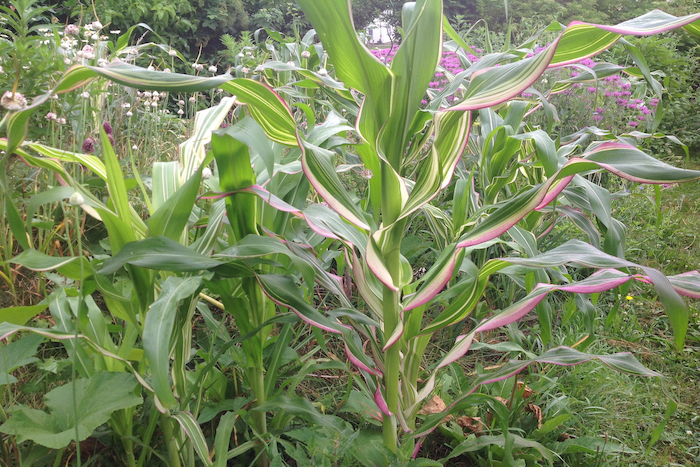
This material is adapted from the upcoming book Beauty in Abundance, now on pre-order.
Thanks to the Permaculture and Regenerative Agriculture movements, everyone knows now that we should reduce the amount of tilling and digging we’re doing on farms and gardens. Digging causes pollution and soil decline, as well as weeds, pests and disease problems for the gardener. So, no-till is a great way to go!
The problem is: how the heck do we actually do it? Most importantly, how do we prep a good seed bed to plant crops into? Especially if we want to avoid plastics and poisons?
Slash-mulch is one of the most promising tools we have for solving this problem.
Academics have often called slash-mulch systems “the most sustainable form of farming ever created by humans.”
While that’s probably debatable, these systems where a mulch crop (or “slash crop”) is grown in place, then slashed to create a deep mulch bed for planting, certainly have a lot to offer the modern regenerative grower. My slash-mulch system allowed me to beat conventional Ag yields over multiple years without weeding, watering or fertilizing – on multiple locations.
And – here’s what’s really special about slash-mulch – it actually increases biodiversity in the field, instead of requiring you to eliminate the biodiversity to grow your crop. Which also makes it good for growers who have a goal of keeping a constant photosynthesising ground coverage.
While some would argue that systems of flood prepping fields, such as the system used by natural farming author Masanobu Fukuoka, are even more sustainable, flooding is dependent on having a sustainable water source around to flood with. Good luck with that if you don’t have a river or snow-capped mountain in your back yard.
For someone inspired to do natural farming in a flat dry region without a river to divert, there are only about a dozen methods to prep a field without tilling. I write about the 13 methods for doing no-till in my new book, Beauty in Abundance.
Unfortunately, the most popular of these no-till methods involve spraying poisons to defoliate the field, and that comes with health risks, harms biodiversity and increases disease and pest pressures on our crops. Other common methods involve heavy use of plastics, (like plastic mulch, “landscape fabric,” solarizing, and smothering with tarps) which research is showing has even greater health risks, contaminating food with microplastics and hormone disrupting chemicals like phthalates. Today, farming (including organic farming) is the world’s fastest growing cause of plastic pollution of the water and soil, and many researchers are alarmed by the damage it’s doing to heath and ecosystems. The vinyl tarps often used for prepping fields has been shown to have the highest risk for microplastics and phthalates, and in some cases these materials are nearly 90% phthalates and leech heavily, which is readily taken up by our plants.
Burning (“slash-and-burn”) may be an option in some cases, but often it isn’t successful in suppressing weeds enough for a good crop. Mulching is an excellent option on a small scale, but usually not economically viable on large areas. Meanwhile, we have historic slash-mulch examples being used on 300 acre plots without fossil fuels or even animals.
Speaking of, animal tractoring can be a very effective way to prep fields, but usually not on a larger scale, and it’s not possible in many circumstances.
Which brings us to the two feasible options I know of for possibly doing natural no-till farming on scale without poisons or plastics: crimp-mulch and slash-mulch.
Personally, I was inspired by Fukuoka’s natural gardening rules: No tilling, no poisons, no weeding, no fertilizer. While crimp-mulch systems (in which mulch is grown in place then crimped to kill it) are very useful on broad acreage, slash-mulch was the only system I knew of that would allow me to meet Fukuka’s rules in my flat, dry location. (Crimp mulch systems usually rely on spraying or tilling or both to plant the mulch crop because crimping only works on certain plants and won’t kill most resident vegetation.)
Slash-mulch systems are considered one of the oldest ways humans have prepped fields, and require no plastic, poisons, or digging. They also are so sustainable, that we have documented examples of long-term cropping in the same field without fertilizer, and with continuous stable yields. In one case, a Cornell paper on the topic recounts an example continuing for at least 300 years.
Slash-mulch systems are very diverse, and there are recorded examples from around the world, including in Europe.
Many of these use a Nitrogen-fixing, aggressive “slash crop” to suppress weeds and fertilize the soil. This is chopped at flowering, creating a dense smothering mulch which large seeds like corn and squash can be planted into. Other historic slash-mulch systems use alley cropping of a bush species like mulberry, which is slashed to mulch the field prior to planting.
My own system was inspired by papers speculating that some North American Native communities grew their Three Sisters Gardens (gardens that majored in corn, beans and squash among other plants) in slash-mulch systems. After a few years of experimenting, I had a dialed in system and began a real 4-year test run.
The System
The slash-crop. The system used an edible meadow guild as a slash-crop. This guild was planted into existing vegetation without ever tilling, mulching or otherwise removing any vegetation. The guild, in addition to growing biomass for slashing, includes many edibles like garlic, walking onions, various chive species, many herbs, amaranth, camas, and several other crops.
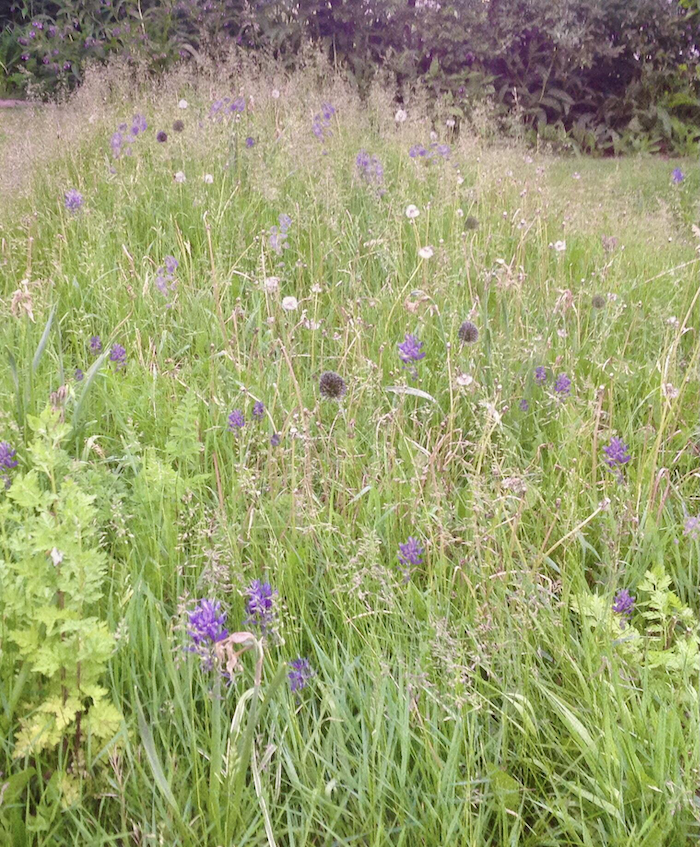
Image by author
The slash: Timing of the slash is important if the goal is to increase biodiversity. I aim for slash right after Spring flowers have started dying back. The mulch is raked into piles and allowed to dry out and brown.
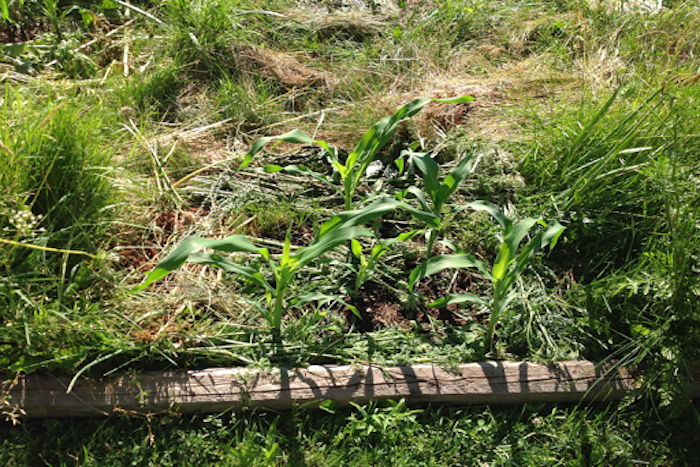
Planting: An important element in getting the system to be self-mulching is to have the density right. Native Americans evolved the best spacing configurations through their research. In my region, the Wompanoag planting design was traditionally used, and that design is highly successful. Other more modern planting designs have failed in my experience. (See image, from Beauty in Abundance.) Careful crop selection is also necessary, and native experts in your region will have the best evolved crops for your area. Seeds are planted directly into the browned mulch layer.
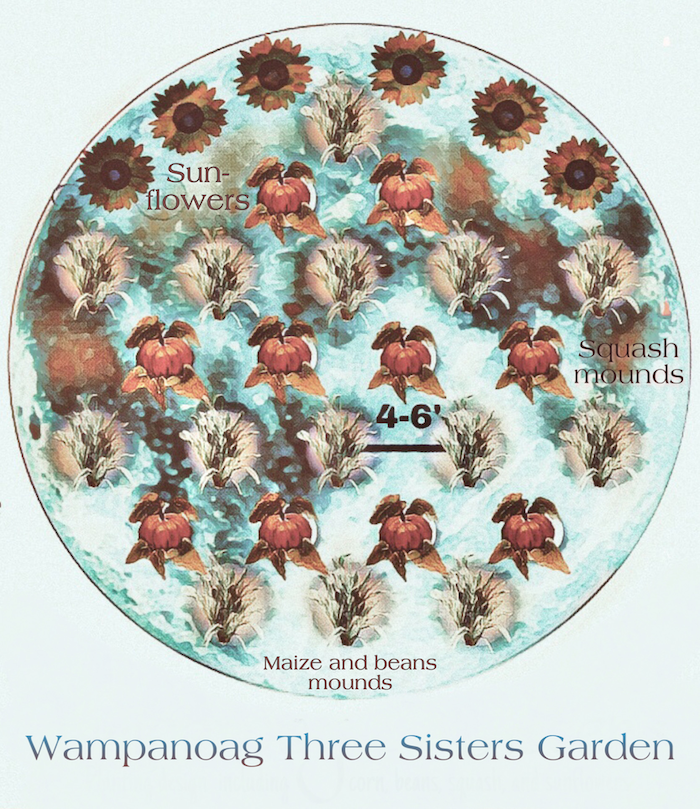
Image provided by author.
The results from multiple years can be seen at TransformativeAdventures.com, but in brief, my yields for corn were on par with our state’s irrigated, fertilized conventional corn yields, but I also harvested garlic, herbs, onions, root crops, tomatoes, various greens, amaranth, beans and squash on top of the corn. Almost no weeding was required due to the mulch. No irrigation or fertilizer was applied. Over the 4 year test period, useful biodiversity in the small field increased significantly, with garlic yields especially being very high.
The Down Sides
The main down-side is that these systems probably require a lot of local experimenting on site to get the timing, spacing and methods just right. Crops sown into slash-mulch are more prone to drying out. Crops sown into wet mulch may be more prone to slug damage. And if the density or mulch are not deep enough, then weeds will return before the crops have established. Slash-mulch systems are also highly dependent on the crop selection. Large seeded varieties or varieties with tubers are necessary. For systems to become self-fertilizing, there must be high biodiversity, N-fixers and quite good soil. Poor soil will probably require amending or years of slash-mulching to improve soil before the yields are good.
Slash-mulch vs. Chop and drop
A frequently asked question: what is the difference between slash-mulch and chop and drop?
Chop and drop is a horticultural technique for weeding a garden, in which weeds are chopped and left in place as mulch. I believe this term was created by Bill Mollison. Chop and drop replaces weeding.
Slash-mulch is a term created by researchers for an agricultural technique for prepping whole fields. The point is that a whole field is prepped with an intentional “slash-crop,” even if that crop is based on the existing “resident vegetation.” Slash-mulch replaces tilling.
Last thoughts
So, I cannot promise you immediate success with a slash-mulch system. Many of my students and colleagues have had mixed results, with some being wildly successful, and others having complete failures due to poor germination, weed issues, or simply not enough fertility.
But I can say that this ancient sustainable technique is very promising for those looking to take the time to find a locally adapted method that works in their region.
For citations or complete details on my methods, visit TransformativeAdventures.com, or see Beauty in Abundance.



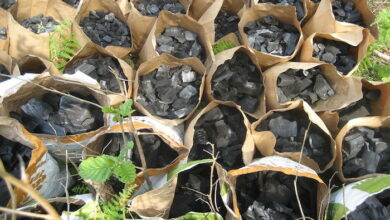









What a nice article, Mike, and so important for growing annual crops in a way that is not depleting soils.
We used to use Mucuna pruriens as a slash and mulch cover crop, and CannavaIia ensoformis also. We have been doing inga alley cropping with good results for the last 10 years.
I look forward to your book being available.
Inga alley cropping is a very interesting slashmulch system, because the inga is both N-fixing and provides multiple secondary yields. I wish we had something so ideal in temperate climates! Still, I would be interested in seeing tight mulch interplantings with the inga mulch. I know some are still tilling or spraying to prep the fields. I really think these systems will have a lot of applications in the future.
Thanks for this.
Here in Trinidad and Tobago farmers refer to chemical fertiliser as “salt” so I have proposed a meme, “all bush (weeds) is salt bush”. My home garden is on a steepish slope and I have taken to chopping the woody stemed mulch plants at about one foot height to support my terraces.